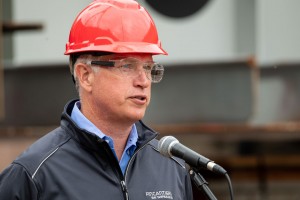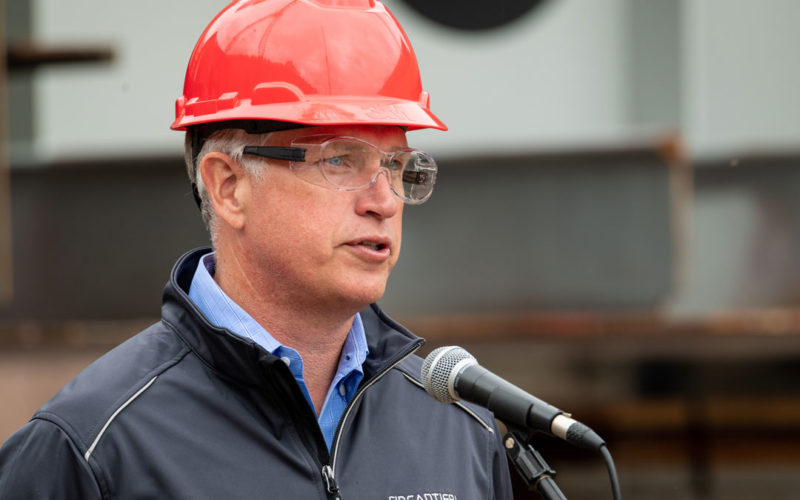
A U.S.-flagged bulk carrier is being built in the Great Lakes region for the first time since 1983. Fincantieri Bay Shipbuilding of Sturgeon Bay, Wis., is midway through the two-year project for Interlake Steamship Co., based in Middleburg Heights, Ohio.
Among its cargoes, the River-class self-unloading ship is anticipated to carry iron ore from Minnesota’s Mesabi Range to a Burns Harbor, Ind., steel plant that made the plates from which the vessel is constructed.
“This life-cycle piece is fascinating because that was once normal in America, and it’s not normal in America anymore,” said Interlake President Mark W. Barker. “We’re talking about Minnesota iron ore mines making iron ore pellets being shipped by U.S.-flagged, U.S.-built, U.S.-crewed ships to U.S. steel mills making steel that is being used in a U.S. shipyard in the Great Lakes.”
It was just after the naval devastation of World War I that Congress passed the Merchant Marine Act of 1920, commonly known as the Jones Act, which requires that all goods transported by water between U.S. ports be carried on U.S.-flagged ships constructed in the United States and owned and crewed by U.S. citizens. Nowhere in the United States are more goods transported between U.S. ports by water than in the Great Lakes, and much of the fleet doing this work was built in the 1950s.
“The Great Lakes are fresh water, so our assets are long-lived, and we have winter maintenance periods when we shut down,” Barker said. “As a company, in the past 12 years we have invested hundreds of millions of dollars into repowering, re-engineering and doing technology upgrades to our existing fleet. While they look like vintage lakers on the outside, inside they are very modern from a technology perspective.”
That longevity means that Fincantieri Bay, which has built several articulated tug-barge (ATB) units in recent years, is now building its first new self-propelled cargo ship in a generation.
“This freighter is exciting for this generation of shipbuilders because this vessel could last 70, 80 or even 90 years,” said Melissa Wollering, a spokeswoman for Fincantieri Marine Group.
Even the ship’s name, Mark W. Barker, evokes a changing of the guard. Interlake Chairman and CEO James R. Barker, who is 85 and has a namesake bulk carrier that has been in service since 1976, has named the new ship after his 48-year-old son as a symbol of the company being part of the industry for a long time to come.
Mark W. Barker will be the 10th vessel in the Interlake fleet, which currently carries about 20 million tons of cargo annually. While some of those ships are too big to pass through the Welland Canal, Mark W. Barker — at 639 feet long and 78 feet wide — will be able to transit the entire St. Lawrence Seaway and navigate the Soo Locks.
“This gives us more flexibility,” Mark W. Barker said. “The Great Lakes ports are on lots of rivers — the Cuyahoga in Cleveland, the Rouge in Detroit, the Maumee in Toledo, and the Calumet in Chicago. We need to be in Cleveland, which has a very narrow and windy river, and this boat has been dimensionally optimized to make sure that it can service that market.”
As one of its primary uses, Mark W. Barker is expected to transport road salt from a mine in Cleveland to municipalities around the Great Lakes. Like the rest of the Interlake fleet, the new ship will be self-discharging, with a conveyor system to dump the salt or other raw materials such as iron ore and stone.
Unlike the rest of the fleet, Mark W. Barker will have a square cargo hold with wide load-bearing hatches — a design not currently used on the U.S. side of the Great Lakes, but one that will make it feasible to transport large objects like wind turbine parts throughout the region.
Construction of the ship is providing work for hundreds of Fincantieri’s skilled trade workers. Partners in the project include the American Bureau of Shipping, ArcelorMittal, Bay Engineering Inc. of Sturgeon Bay, EMD, Caterpillar, EMS-Tech, Lufkin, Kongsberg and MacGregor.
The new bulk carrier is scheduled to undergo sea trials in spring 2022.

